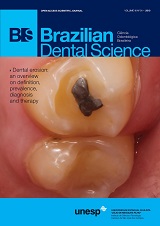A comparison of methods used to determine chewing side preference in deciduous, mixed and permanent dentitions
DOI:
https://doi.org/10.14295/bds.2013.v16i1.870Resumo
Objective: The purpose of this study was to determine whether ‘chewing side preference’ (CSP) is correlated to ‘chewing side preference during the first chewing cycle’ (CSP1ºC) in the deciduous, mixed and permanent dentitions.Methods: Three-hundred subjects were divided in 3 groups: Group 1 – 100 children 3-5 years old, primary dentition; Group 2 – 100 children 6-12 years old, mixed dentition; Group 3 – 100 subjects 18-47 years old, permanent dentition. CSP was determined using a method developed by McDonnell et al. (2004). Subjects were given a piece of gum and the position of the chewing gum was recorded 7 times as right or left. Subjects were classified as ‘observed preferred chewing side’ (OPCS) when they performed 5/7, 6/7 or 7/7 strokes on the same side. OPCS corresponded to the CSP. CSP1ºC was determined using a method developed by Hoogmartens and Caubergh (1987). Subjects were given five pieces of gum and the position of the chewing gum at first chewing cycle was recorded as right or left. For each subject, an index (I) was performed. The Chi-square (X2) and phi correlation (r) tests were used to investigate signi?cant correlations between CSP and CSP1ºC. Results: There was a strong positive and significant correlation between CSP and CSP1ºC for primary dentition (p=0.000; r=0.82), for mixed dentition (p=0.000; r=0.81) and a very strong positive and significant correlation for permanent dentition (p=0.000; r=0.90). Conclusion: CSP can be significantly correlated to CSP1ºC for primary dentition, mixed dentition and permanent dentition, and these are strong positive relationships for primary and mixed dentitions and very strong positive relationship for permanent dentition.
Downloads
Downloads
Publicado
Como Citar
Edição
Seção
Licença
TRANSFERÊNCIA DE DIREITOS AUTORAIS E DECLARAÇÃO DE RESPONSABILIDADE
Toda a propriedade de direitos autorais do artigo "____________________________________________________________________" é transferido do autor(es) para a CIÊNCIA ODONTOLÓGICA BRASILEIRA, no caso do trabalho ser publicado. O artigo não foi publicado em outro lugar e não foi submetido simultaneamente para publicação em outra revista.
Vimos por meio deste, atestar que trabalho é original e não apresenta dados manipulados, fraude ou plágio. Fizemos contribuição científica significativa para o estudo e estamos cientes dos dados apresentados e de acordo com a versão final do artigo. Assumimos total responsabilidade pelos aspectos éticos do estudo.
Este texto deve ser impresso e assinado por todos os autores. A versão digitalizada deverá ser apresentada como arquivo suplementar durante o processo de submissão.




























